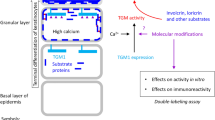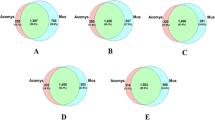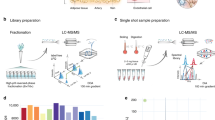Abstract
PROGRESS in understanding keratinization of the epidermis has been hampered by the difficulty of preparing a reproducible keratinous protein from the epidermal tissue1,2. Several laboratories1–5 have obtained an alkali- or urea-extractable protein from human, mouse, and cow's snout epidermis which precipitates from solutions at pH 5.5. This protein is present in large amounts in fully keratinized human epidermal tissue (callus or stratum corneum)1,2 and is believed to represent epidermal “keratin”. Matoltsy6–8 has isolated and characterized a similar protein from cow's snout epidermis which is soluble in acetic acid. This protein is termed “prekeratin” by virtue of its ready solubility from whole epidermis which includes incompletely keratinized cells (full-thickness cow's snout epidermis). This report compares human callus keratin (protein precipitating at pH 5.5) with the prekeratin of Matoltsy. Their similarities heighten optimism concerning the definition of an epidermal keratin sub-unit.
This is a preview of subscription content, access via your institution
Access options
Subscribe to this journal
Receive 51 print issues and online access
$199.00 per year
only $3.90 per issue
Buy this article
- Purchase on Springer Link
- Instant access to full article PDF
Prices may be subject to local taxes which are calculated during checkout
Similar content being viewed by others
References
Crounse, R. G., Nature, 200, 539 (1963).
Crounse, R. G., The Epidermis, edit. by Montagna, W., and Lobitz, jun., W. C., 365 (Academic Press, New York, 1964).
Rudall, K. M., Adv. Protein Chem., 7, 253 (1952).
Carruthers, C., et al., J. Invest. Dermatol., 25, 189 (1955).
Rothberg, S., J. Invest. Dermatol., 34, 197 (1960).
Matoltsy, A. G., Nature, 201, 1130 (1964).
Matoltsy, A. G., Nature, 204, 380 (1965).
Matoltsy, A. G., in Biology of the Skin and Hair Growth, edit. by Lyne, A. G., and Short, B. F., 291 (Angus and Robertson, Sydney, 1965).
Andrews, P., Biochem. J., 91, 222 (1964).
Crounse, R. G., Arch. Environ. Health, 11, 522 (1965).
Crounse, R. G., J. Invest. Dermatol. (in the press).
Downes, A. M., Sharry, L. F., and Rogers, G. E., Nature, 199, 1059 (1963).
Crounse, R. G., in Biology of Skin and Hair Growth, edit. by Lyne, A. G., and Short, B. F., 307 (Angus and Robertson, Sydney, 1965).
Bernstein, I. A., in The Epidermis, edit. by Montagna, W., and Lobitz, jun., W. C., 478 (Academic Press, New York, 1964).
Reaven, E. P., and Cox, A. J., J. Invest. Dermatol., 45, 422 (1965).
Author information
Authors and Affiliations
Rights and permissions
About this article
Cite this article
CROUNSE, R. Epidermal Keratin and Epidermal Prekeratin. Nature 211, 1301–1302 (1966). https://doi.org/10.1038/2111301a0
Issue Date:
DOI: https://doi.org/10.1038/2111301a0
This article is cited by
Comments
By submitting a comment you agree to abide by our Terms and Community Guidelines. If you find something abusive or that does not comply with our terms or guidelines please flag it as inappropriate.



